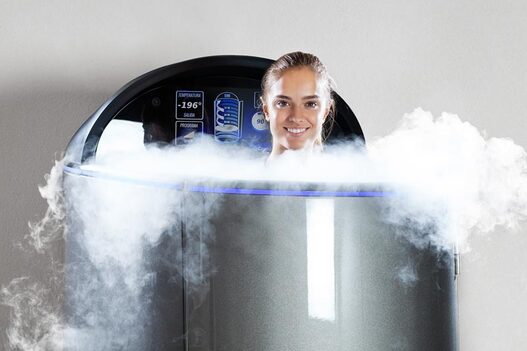Cryotherapy
What is cryotherapy?
Cryotherapy is the exposure of the body surface to very low temperatures (between -110º to -196ºC), for a short period of time (from 2 to 4 minutes). This is possible thanks to the use of the evaporated liquid nitrogen, always in a controlled environment and under medical supervision. Extreme conditions of cold are used to create a body response. This response has three levels: circulatory, muscular and neuroendocrine.
The reduction in the superficial skin temperature stimulates the thermoreceptors (sensors that react with cold stimulations). Thermoreceptors send a signal to the brain in order to generate a response as a defense mechanism to the imminent hypothermia situation.
Cryotherapy is the exposure of the body surface to very low temperatures (between -110º to -196ºC), for a short period of time (from 2 to 4 minutes). This is possible thanks to the use of the evaporated liquid nitrogen, always in a controlled environment and under medical supervision. Extreme conditions of cold are used to create a body response. This response has three levels: circulatory, muscular and neuroendocrine.
The reduction in the superficial skin temperature stimulates the thermoreceptors (sensors that react with cold stimulations). Thermoreceptors send a signal to the brain in order to generate a response as a defense mechanism to the imminent hypothermia situation.
Cryotherapy and its history
Whole body cryotherapy, as we know it, was developed in the late 70’s in Japan by Dr. Toshima Yamauchi. This doctor found a method to cool the body surface using nitrogen in gaseous state avoiding freezing the subcutaneous part. Dr. Yamauchi used it for with therapeuthical purposes to treat patients with rheumatoid arthritis.
The ancient Egyptians already used cold therapies as beauty and wellness treatments. Its effectiveness has been demonstrated with time. Lowering the skin surface’s temperature leads to releasing endorphins, producing a feeling of wellness and pain relief.
The investigations carried out in the last two decades, specially in Europe and Germany (Dr. Fricke) and Poland (Dr. Zagrobelny), have confirmed the therapeutic efficacy of the cryotherapy in many areas. The main investigation lines are related with treatment of pain and musculoskeletal disorders.
Whole body cryotherapy, as we know it, was developed in the late 70’s in Japan by Dr. Toshima Yamauchi. This doctor found a method to cool the body surface using nitrogen in gaseous state avoiding freezing the subcutaneous part. Dr. Yamauchi used it for with therapeuthical purposes to treat patients with rheumatoid arthritis.
The ancient Egyptians already used cold therapies as beauty and wellness treatments. Its effectiveness has been demonstrated with time. Lowering the skin surface’s temperature leads to releasing endorphins, producing a feeling of wellness and pain relief.
The investigations carried out in the last two decades, specially in Europe and Germany (Dr. Fricke) and Poland (Dr. Zagrobelny), have confirmed the therapeutic efficacy of the cryotherapy in many areas. The main investigation lines are related with treatment of pain and musculoskeletal disorders.
Main effects of cryotherapy
- An analgesic effect: cryotherapy has proved to be very effective in the treatment of acute and chronic pain. This is the case of patients with fibromyalgia. The extreme cold of the cryotherapy decreases the speed of nerve conduction and inhibits nociceptive fibers, helping to reduce the feeling of pain.
- Anti-inflammatory effect: cryotherapy has an influence in the inflammatory process in a similar way as explained in the case of pain relief. The application of extreme cold on the skin causes a reduction of hyperfusion dependent on inflammation through vasoconstriction. It also causes the desensitization of the nociceptors, a reduction of the muscular tone and a reduction of mediators of inflammation.
- Metabolic activation: the extreme cold generated inside the cabin produces some reactions in the organism in order to compensate the decrease in the temperature of the outer surface of the skin. It activates the metabolism and the mobilization of accumulated fats. It can burn between 200 and 800 kilocalories per session. The loss of kilocalories is not only during the three minutes of the application of cold, but also during the next six hours
- Relaxation: cryotherapy promotes the release of endorphins and serotonin, as well as, other natural substances that produce a feeling of well-being and that help to combat stress.
- It produces a vasoconstriction followed by a vasodilatation. Due to the extreme cold, the brain sends a signal to transport blood to the vital organs. There, blood is enriched with oxygen and another nutrients and toxins are purified. After exiting the cryosauna the vasodilatation takes place: enriched blood goes back to the peripheral systems of the body.
- It releases substances as endorphins, that produce a feeling of well-being.
- Through neuroreflexive mechanisms, positive results are obtained regarding pain sensitivity and inflammatory processes.


